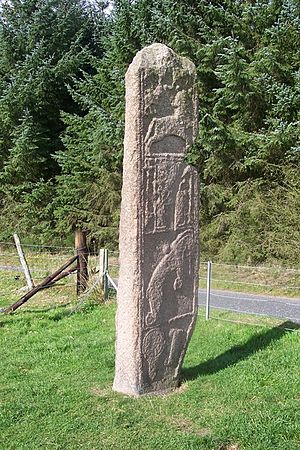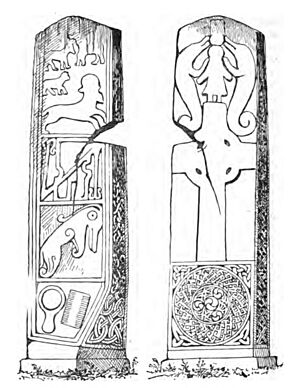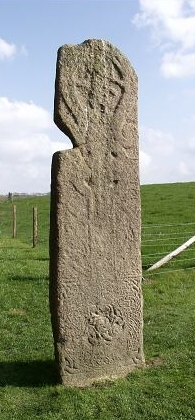Maiden Stone facts for kids
The Maiden Stone is a very old standing stone in Scotland. It's also known as the Drumdurno Stone because it's close to a farm called Drumdurno. You can find this special stone near Inverurie in Aberdeenshire. Experts believe it was made by the Picts around the 9th century AD.
Contents
Why is it Called the Maiden Stone?
The name "Maiden Stone" comes from a local story. This story explains a triangular mark near the top of the stone.
The legend says that a young woman, the daughter of the Laird of Balquhain, made a bet. She challenged a stranger that she could bake a bannock (a type of bread) faster than he could build a road. This road was to go all the way to the top of Bennachie hill. If she lost, she would have to marry the stranger.
But the stranger was actually the Devil! He finished the road very quickly. The maiden ran away from him and prayed for help. The story ends by saying that God turned her into stone to save her. The triangular notch on the stone is said to be where the Devil grabbed her shoulder as she ran.
What Was the Stone Used For?
The Maiden Stone has many different carvings on it. Some of these carvings are Pictish symbols, which are very old. Others are Christian symbols.
Because of this mix, many people think the stone was a special place. It was probably used as a preaching site. This means missionaries might have stopped here to teach the Picts about Christianity.
What Does the Maiden Stone Look Like?
The Maiden Stone is made of red granite. It stands about 3.01 meters (nearly 10 feet) tall. This makes it one of the tallest Pictish monuments ever found! Even though a small part of the top is missing from weather damage, it's still very impressive.
It's known as a Class II Pictish monument. This means it has both Christian and older Pictish designs. It was carved in the late 700s or early 800s AD.
Details on the Stone's Sides
- West Side: This side shows a cross with a ring around it. Below the cross, there's a human figure. This figure is placed between two "fish-monsters." Below the cross, there's a square panel. Inside this panel, you can see a disc with a cool Celtic spiral design. This is surrounded by a pattern that looks like a key. The corners are filled with knotwork patterns.
- East Side (Reverse): This side has four main sections. The top section shows a large centaur (a creature that is half-human, half-horse). Below it are three figures that are hard to see now. They might be two smaller centaurs wrestling and a dog. The next section has a "notched rectangle and Z-rod" symbol. Below that is a Pictish Beast symbol, followed by a mirror and a comb.
- Narrow Edges: The north edge has a knotwork pattern. The south edge has a keywork pattern. Some parts of the north edge are missing. Many of the patterns, especially on the west face, are worn away by time.
The human figure and "fish-monsters" on the west side might tell a story. They could represent the Biblical story of Jonah and the Whale. The whale might be shown twice to make the design look balanced.
The Maiden Stone is a protected ancient monument. Historic Environment Scotland takes care of it. You can visit it anytime to see this amazing piece of history!




